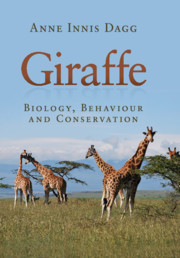Book contents
- Frontmatter
- Dedication
- Contents
- Preface
- Acknowledgements
- List of abbreviations
- 1 Time-line of giraffe
- 2 The giraffe’s environment
- 3 Feeding in the wild
- 4 Social behaviour and populations
- 5 Individual behaviours
- 6 External features
- 7 Anatomy
- 8 Physiology
- 9 Pregnancy, growth, reproduction and aging
- 10 Giraffe in zoos
- 11 Status and conservation of giraffe races
- Appendix Parasites and pathogens
- References
- Index
4 - Social behaviour and populations
Published online by Cambridge University Press: 05 February 2014
- Frontmatter
- Dedication
- Contents
- Preface
- Acknowledgements
- List of abbreviations
- 1 Time-line of giraffe
- 2 The giraffe’s environment
- 3 Feeding in the wild
- 4 Social behaviour and populations
- 5 Individual behaviours
- 6 External features
- 7 Anatomy
- 8 Physiology
- 9 Pregnancy, growth, reproduction and aging
- 10 Giraffe in zoos
- 11 Status and conservation of giraffe races
- Appendix Parasites and pathogens
- References
- Index
Summary
For reproductive behaviour and behaviour in zoos, see Chapters 9 and 10.
How social animals behave among themselves is of great interest to behaviourists, but also to those who oversee wildlife populations (Carter, 2009). For example, if a contagious disease is present in one individual, how that animal interacts with others will help a manager figure out how the disease might spread, and therefore how it might best be combatted. Or if a few individuals are going to be transported to another area, picking giraffe who are friends to travel together will ease this process.
Now that we know from DNA samples that most subspecies of giraffe have been isolated from each other for very long periods of time, and therefore may actually be separate species, it would be exciting to find whether these ‘species’ have unique social behavioural patterns too. This may be true, but we won’t know this any time soon. There are far too few studies of behaviour, each of which is incredibly labour-intensive and expensive. As well, it has already been shown, as we shall see in this chapter, that behaviour is shaped in part by local environments and by group composition. In this chapter it is assumed that giraffe of all races behave in more or less the same way.
- Type
- Chapter
- Information
- GiraffeBiology, Behaviour and Conservation, pp. 39 - 59Publisher: Cambridge University PressPrint publication year: 2014



